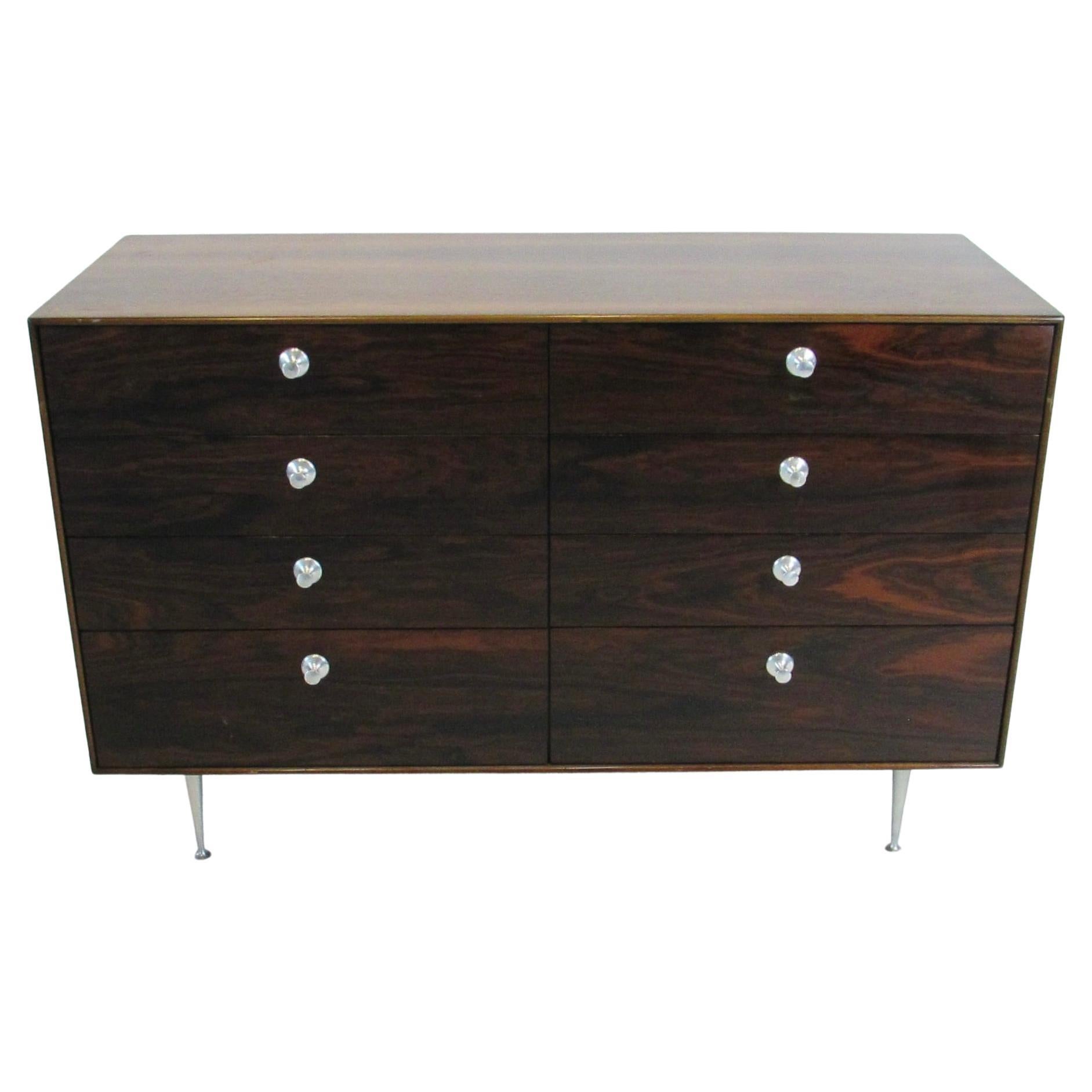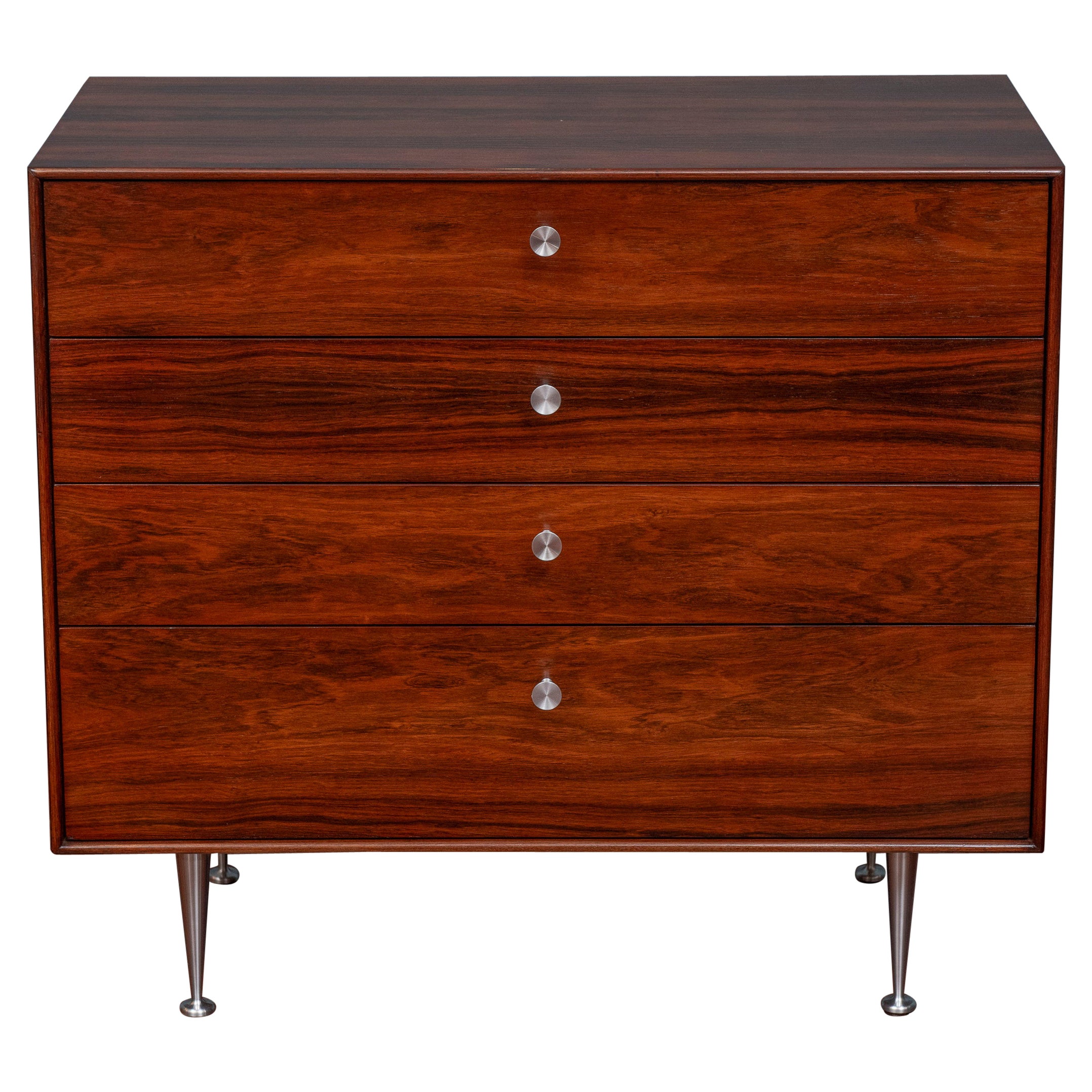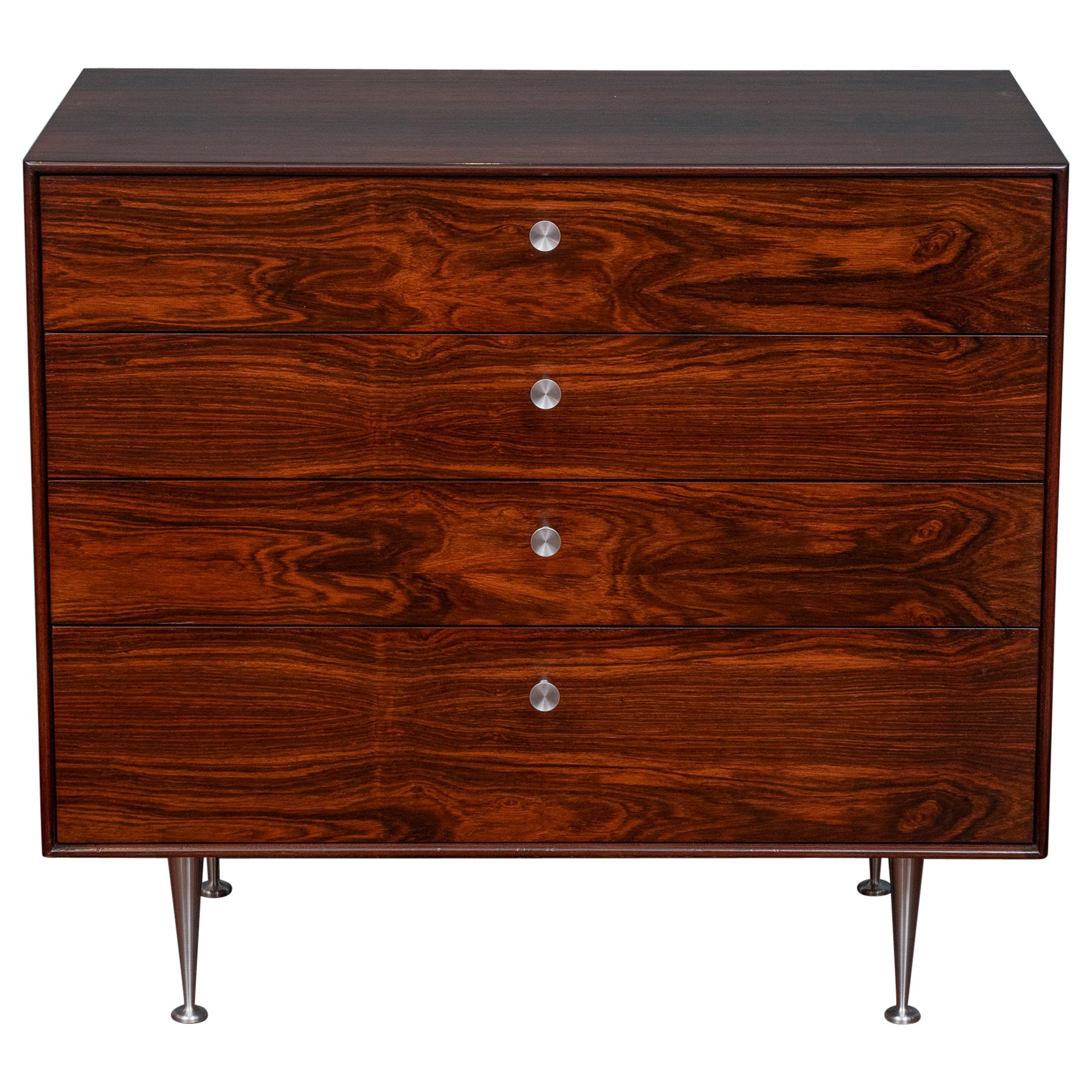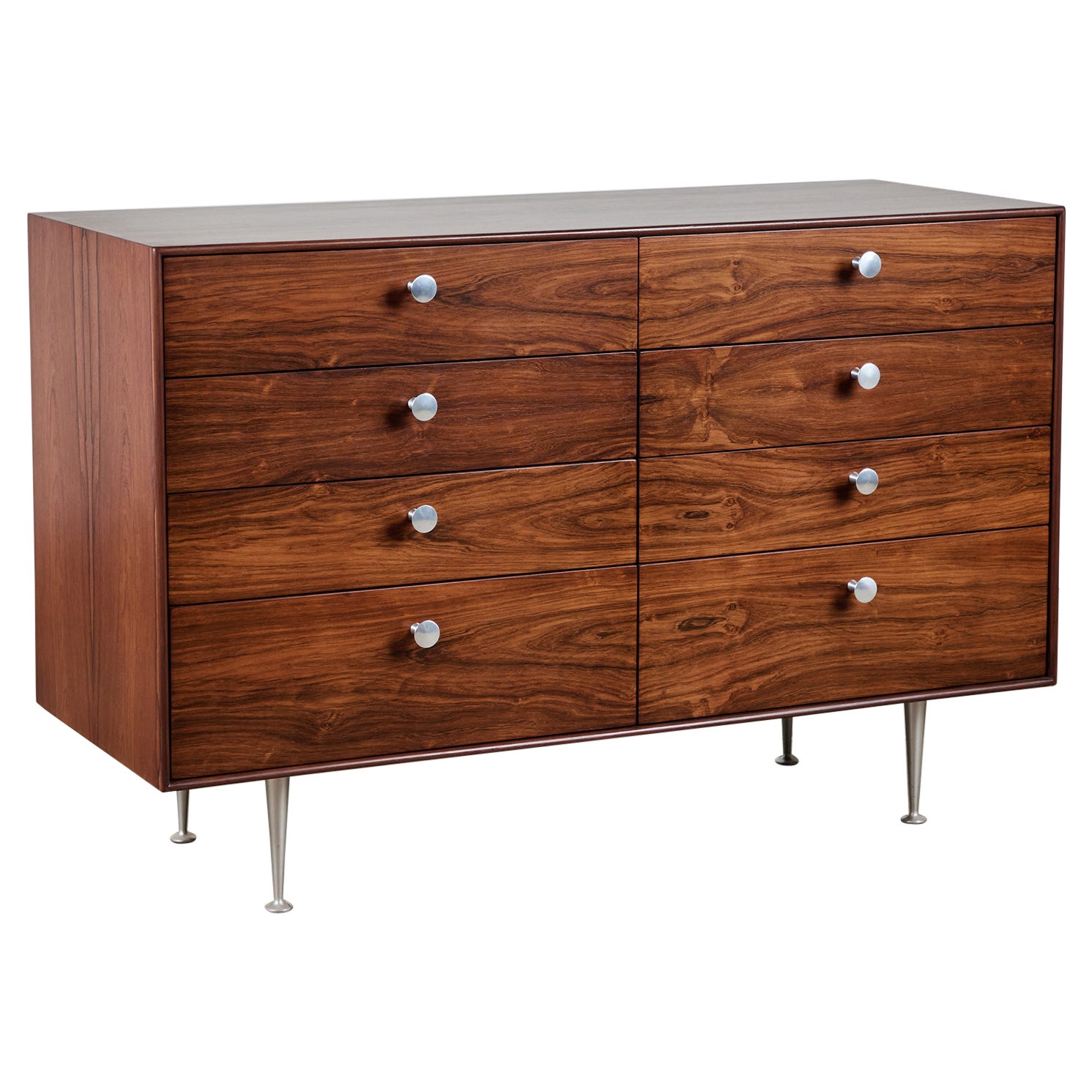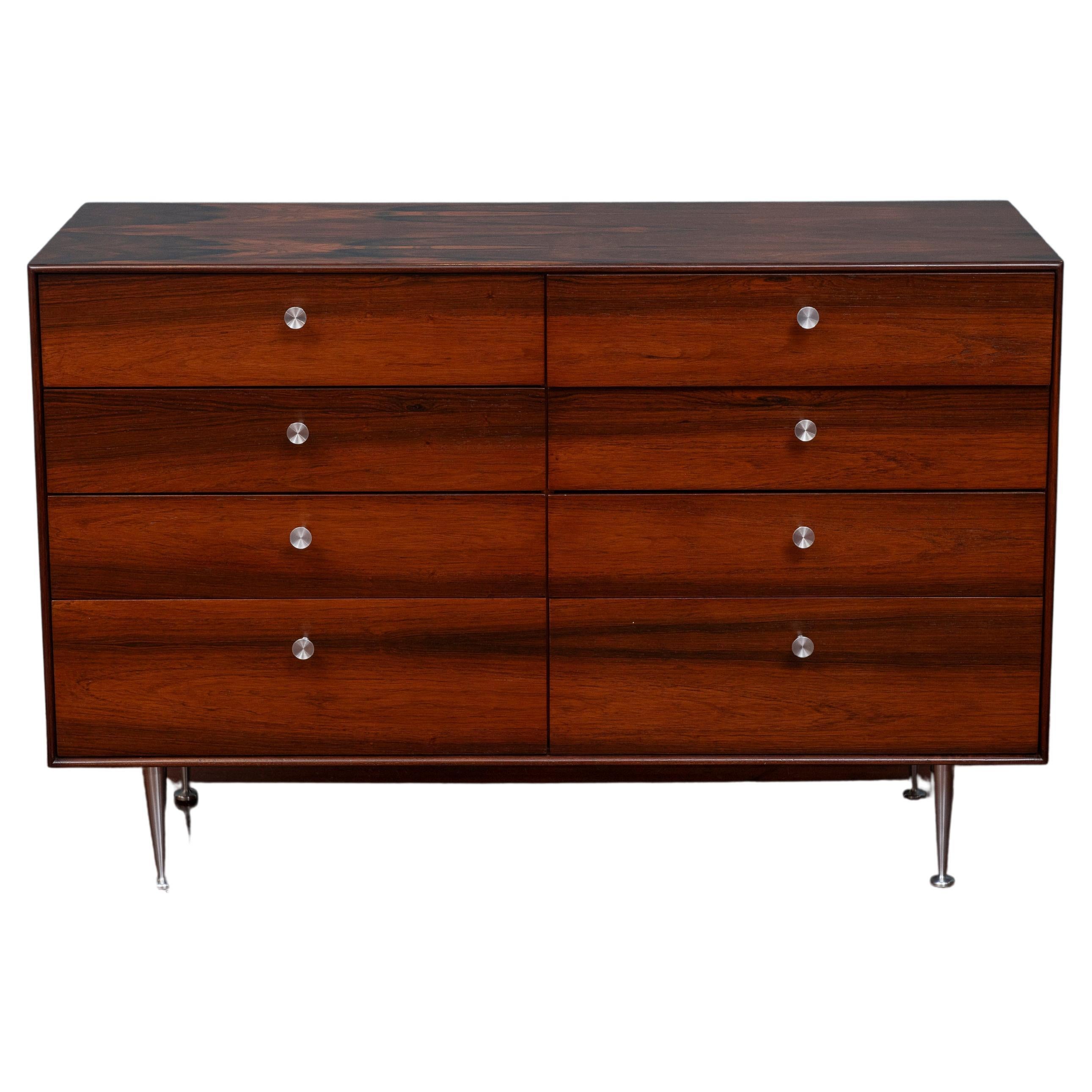George Nelson Rosewood Thin Edge 4 drawer Dresser by Herman Miller #2
About the Item
- Creator:George Nelson (Designer)
- Design:
- Dimensions:Height: 30.5 in (77.47 cm)Width: 18.5 in (46.99 cm)Depth: 33.75 in (85.73 cm)
- Style:Mid-Century Modern (Of the Period)
- Materials and Techniques:
- Place of Origin:
- Period:
- Date of Manufacture:Circa 1950
- Condition:Refinished. Wear consistent with age and use.
- Seller Location:San Diego, CA
- Reference Number:1stDibs: LU6417239079142
George Nelson
Architect, designer, and writer George Nelson was a central figure in the mid-century American modernist design movement; and his thoughts influenced not only the furniture we live with, but also how we live.
Nelson came to design via journalism and literature. Upon receiving his bachelor’s degree in architecture from Yale in 1931, he won the Prix de Rome fellowship, and spent his time in Europe writing magazine articles that helped bring stateside recognition to Ludwig Mies van der Rohe, Gio Ponti, Le Corbusier and other canonical modernist architects. In the 1940s, Nelson wrote texts that suggested such now-commonplace ideas as open-plan houses, storage walls and family rooms. D.J. De Pree, the owner of the furniture maker Herman Miller, was so impressed by Nelson that in 1944 — following the sudden death of Gilbert Rohde, who had introduced the firm to modern design in the 1930s — he invited Nelson to join the company as its design director.
There Nelson’s curatorial design talents came to the fore. To Herman Miller he brought such eminent creators as Charles and Ray Eames, Isamu Noguchi, and the textile and furniture designer Alexander Girard. Thanks to a clever contract, at the same time as he directed Herman Miller he formed a New York design company, George Nelson & Associates, that sold furniture designs to the Michigan firm, as well as its competitor, the Howard Miller Clock Company. Nelson’s New York team of designers (who were rarely individually credited) would create such iconic pieces as the Marshmallow sofa, the Coconut chair, the Ball clock, the Bubble lamp series and the many cabinets and beds that comprise the sleek Thin-Edge line.
For dedicated collectors, as well as for interior designers who look beyond “the look,” there is a “cool-factor” inherent to vintage pieces from George Nelson and others. Nelson was in on it from the start, and it’s valuable to have a piece that was there with him. But still, as is evident from the offerings from dealers on these pages, in any of the designs, in any iteration whose manufacture Nelson oversaw and encouraged, there are shining elements of lightness, elegance, sophistication — and a little bit of swagger. George Nelson felt confident in his ideas about design and didn’t mind letting the world know.
- ShippingRetrieving quote...Ships From: San Diego, CA
- Return PolicyA return for this item may be initiated within 1 day of delivery.
- Arne Vodder Triennale 4 Drawer Dresser by Sibast (2 available)By Sibast, Arne VodderLocated in San Diego, CAAn iconic design by Arne Vodder Triennale 4-drawer dresser was produced by Sibast Mobler, circa 1950. Constructed in teak, the 4-drawer dresser i...Category
Vintage 1950s Danish Scandinavian Modern Dressers
MaterialsTeak
- George Nakashima "Origins' Walnut Dresser for WiddicombBy George Nakashima, Widdicomb Furniture Co.Located in San Diego, CAA very rare and exceptional mid-century Organic Modern monumental triple dresser. The Origins Group was created by George Nakashima, widely considered one of the world's greatest ...Category
Mid-20th Century American Mid-Century Modern Dressers
MaterialsBrass
- Glenn of California Dresser by Richard ThompsonBy Richard Thompson, Glenn of CaliforniaLocated in San Diego, CAThis incredible 6 drawer dresser was designed by Richard Thompson for Glenn of California circa 1950s. It has a sleek walnut wood case with integrated legs and retractable inlaid ros...Category
Mid-20th Century American Mid-Century Modern Dressers
MaterialsRosewood, Walnut
- Glenn of California Gentleman's Dresser by Richard ThompsonBy Glenn of California, Richard ThompsonLocated in San Diego, CAGlenn of California dresser or gentleman's chest designed by Richard Thompson. The case is made of walnut and has retractable inlaid rosewood pulls. The walnut is a golden warm color...Category
Mid-20th Century American Mid-Century Modern Dressers
MaterialsRosewood, Walnut
- Paul McCobb Calvin Group Irwin Collection Dresser with Pink Marble TopBy Paul McCobbLocated in San Diego, CAPaul McCobb Calvin Group Dresser with dark Mahogany case, wood legs and stretcher and awesome pink marble Top. 2 doors open to reveal 4 drawers and an open cabinet with adjustable sh...Category
Vintage 1950s American Mid-Century Modern Dressers
MaterialsMarble
- Arne Vodder "Triennale" Teak Dresser with Blue Bowtie Drawers for Sibast MøblerBy Arne VodderLocated in San Diego, CAAn iconic design by Arne Vodder 'Triennale' dresser was produced by Sibast Mobler, circa 1950. Constructed in teak, the long eight drawer dresser is a classic piece of danish modern ...Category
Mid-20th Century Swedish Mid-Century Modern Dressers
MaterialsTeak
- George Nelson Herman Miller Rosewood Thin Edge Eight Drawer DresserBy George Nelson, Herman MillerLocated in Ferndale, MIBeautifully grained Rosewood cabinet with two rows of four drawers. Early style turned aluminum pulls on each drawer. Cabinet standing on for turned aluminum legs. This is a classic ...Category
Mid-20th Century American Mid-Century Modern Dressers
MaterialsAluminum
- George Nelson Rosewood Thin Edge Dresser for Herman MillerBy George Nelson, Herman MillerLocated in San Francisco, CAGeorge Nelson Thin Edge Group eight drawer dresser for Herman Miller. Made with high quality construction and detail in Brazilian rosewood and oak with drawer dividers to help with ...Category
Vintage 1960s American Mid-Century Modern Dressers
MaterialsAluminum
- George Nelson Rosewood Thin Edge Dresser for Herman MillerBy George Nelson, Herman MillerLocated in San Francisco, CAGeorge Nelson design rosewood "Thin Edge" chest or dresser for Herman Miller, U.S.A. Exceptional rosewood grain patterns throughout the case and drawer fronts with new spinning top a...Category
Vintage 1950s American Mid-Century Modern Dressers
MaterialsAluminum
- George Nelson Rosewood Thin Edge Dresser for Herman MillerBy George Nelson, Herman MillerLocated in San Francisco, CAGeorge Nelson rosewood Thin Edge chest or dresser for Herman Miller, U.S.A. Exceptional rosewood grain patterns throughout just ...Category
Vintage 1950s American Mid-Century Modern Dressers
MaterialsAluminum
- George Nelson Rosewood Thin Edge Dresser for Herman MillerBy George Nelson, Herman MillerLocated in Los Angeles, CAAn eight-drawer double dresser from George Nelson’s Thin Edge collection for Herman Miller. Design features the slender rosewood case for which the series was named and a double stac...Category
Mid-20th Century American Mid-Century Modern Dressers
MaterialsAluminum
- George Nelson Rosewood Thin Edge Dresser for Herman MillerBy George Nelson, Herman MillerLocated in San Francisco, CAGeorge Nelson design "Thin Edge" dresser for Herman Miller Model 5221, U.S.A. Eight drawers that graduate in size from top to bottom and operate effortlessly. Polished aluminum spinn...Category
Vintage 1950s American Mid-Century Modern Dressers
MaterialsAluminum
Recently Viewed
View AllRead More
A Guide to Herman Miller’s Most Iconic Furniture
The prolific manufacturer has partnered with many of the world’s top designers since opening its doors in 1923. Here are some of the company’s greatest hits, which helped transform the American home and office.
Kule and Forsyth Give Iconic Furniture a Bold Makeover with Stripes
Maggie and Anne Genovese, of Forsyth, teamed up with fashion designer Nikki Kule to reimagine some classic pieces.
